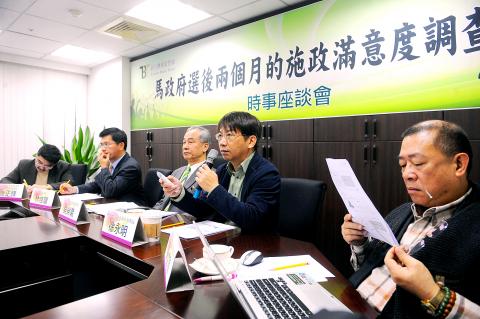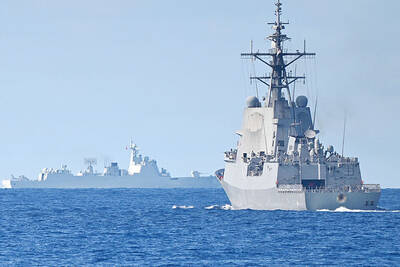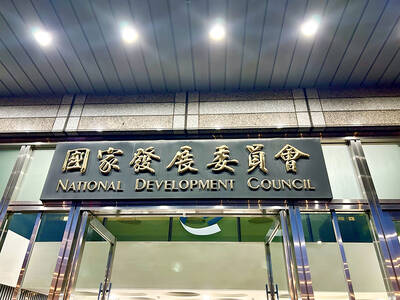President Ma Ying-jeou’s (馬英九) approval rating has plummeted to its lowest level since the aftermath of Typhoon Morakot in 2009 amid recent controversies over US beef and avian flu, a recent poll showed.
Only 26.1 percent of respondents said they were satisfied with Ma’s performance, with 62.1 percent disapproving of the president, the survey conducted by Taiwan Brain Trust think tank on Wednesday and Thursday showed.
Those figures were the lowest since August 2009, when Ma’s approval ratings dropped to 16 percent after his handling of Morakot, the deadliest typhoon in Taiwan’s history, which killed hundreds of Taiwanese, the think tank said.

Photo: Wang Min-wei, Taipei Times
“The numbers signal a crisis for the Ma administration and, as you can see, the situation is getting worse,” Democratic Progressive Party (DPP) Legislator Lin Chia-lung (林佳龍) said.
Responses to almost all the questions asked in the survey were unfavorable to Ma. More than half of respondents said they were unhappy with his performance over US beef imports, the H5N2 avian flu outbreak, rising commodity prices and tax reform.
On the recent US beef controversy, 54.8 percent of respondents questioned Ma’s integrity, because he pledged not to lift the ban on the growth additive ractopamine during the election campaign. A total of 67.7 percent disapproved of the government’s conditional lifting of the ban.
When asked about the alleged cover-up of an avian flu outbreak, 54.1 percent of respondents said they believed that government agencies had deliberately concealed information and 73.8 percent said the government’s handling of the outbreak was unacceptable.
These results suggest two problems in the Ma administration — lack of integrity and incompetence, Lin said.
Shih Cheng-feng (施正鋒), a professor at National Dong Hwa University, said Ma’s role in the recent controversies reflected a serious flaw in Taiwan’s Constitution.
At the beginning of his term in office, Ma was able to sit in the Presidential Office and do nothing, while claiming to be simply -fulfilling a role regulated by the Constitution, whereas he now “seems have his hands on everything” and is ignoring the Executive Yuan, Shih said.
According to the survey, Ma’a approval ratings never exceeded 40 percent after May 2009, one year after he took office.
Shih also highlighted the implications of answers to one of the survey questions, namely that 76.6 percent of respondents believed that public health was more important than relations with the US.
“It appears to me that people are more hostile to the US than they were and the Ma administration is going to have to work even harder to mend relations with Washington in the future,” he said.
Shih also said that former DPP chairperson Tsai Ing-wen (蔡英文), an experienced negotiator on trade issues who is familiar with international affairs, should have been playing a more prominent role for the DPP during the recent controversies over US beef and avian flu.
The survey, which collected 1,116 samples and had a margin of error of plus or minus 3 percent, also found that 53.1 percent of respondents were not satisfied with the new Cabinet led by Premier Sean Chen (陳冲).

RESPONSE: The transit sends a message that China’s alignment with other countries would not deter the West from defending freedom of navigation, an academic said Canadian frigate the Ville de Quebec and Australian guided-missile destroyer the Brisbane transited the Taiwan Strait yesterday morning, the first time the two nations have conducted a joint freedom of navigation operation. The Canadian and Australian militaries did not immediately respond to requests for comment. The Ministry of National Defense declined to confirm the passage, saying only that Taiwan’s armed forces had deployed surveillance and reconnaissance assets, along with warships and combat aircraft, to safeguard security across the Strait. The two vessels were observed transiting northward along the eastern side of the Taiwan Strait’s median line, with Japan being their most likely destination,

GLOBAL ISSUE: If China annexes Taiwan, ‘it will not stop its expansion there, as it only becomes stronger and has more force to expand further,’ the president said China’s military and diplomatic expansion is not a sole issue for Taiwan, but one that risks world peace, President William Lai (賴清德) said yesterday, adding that Taiwan would stand with the alliance of democratic countries to preserve peace through deterrence. Lai made the remark in an exclusive interview with the Chinese-language Liberty Times (sister paper of the Taipei Times). “China is strategically pushing forward to change the international order,” Lai said, adding that China established the Asia Infrastructure Investment Bank, launched the Belt and Road Initiative, and pushed for yuan internationalization, because it wants to replace the democratic rules-based international

ECONOMIC BOOST: Should the more than 23 million people eligible for the NT$10,000 handouts spend them the same way as in 2023, GDP could rise 0.5 percent, an official said Universal cash handouts of NT$10,000 (US$330) are to be disbursed late next month at the earliest — including to permanent residents and foreign residents married to Taiwanese — pending legislative approval, the Ministry of Finance said yesterday. The Executive Yuan yesterday approved the Special Act for Strengthening Economic, Social and National Security Resilience in Response to International Circumstances (因應國際情勢強化經濟社會及民生國安韌性特別條例). The NT$550 billion special budget includes NT$236 billion for the cash handouts, plus an additional NT$20 billion set aside as reserve funds, expected to be used to support industries. Handouts might begin one month after the bill is promulgated and would be completed within

The National Development Council (NDC) yesterday unveiled details of new regulations that ease restrictions on foreigners working or living in Taiwan, as part of a bid to attract skilled workers from abroad. The regulations, which could go into effect in the first quarter of next year, stem from amendments to the Act for the Recruitment and Employment of Foreign Professionals (外國專業人才延攬及僱用法) passed by lawmakers on Aug. 29. Students categorized as “overseas compatriots” would be allowed to stay and work in Taiwan in the two years after their graduation without obtaining additional permits, doing away with the evaluation process that is currently required,